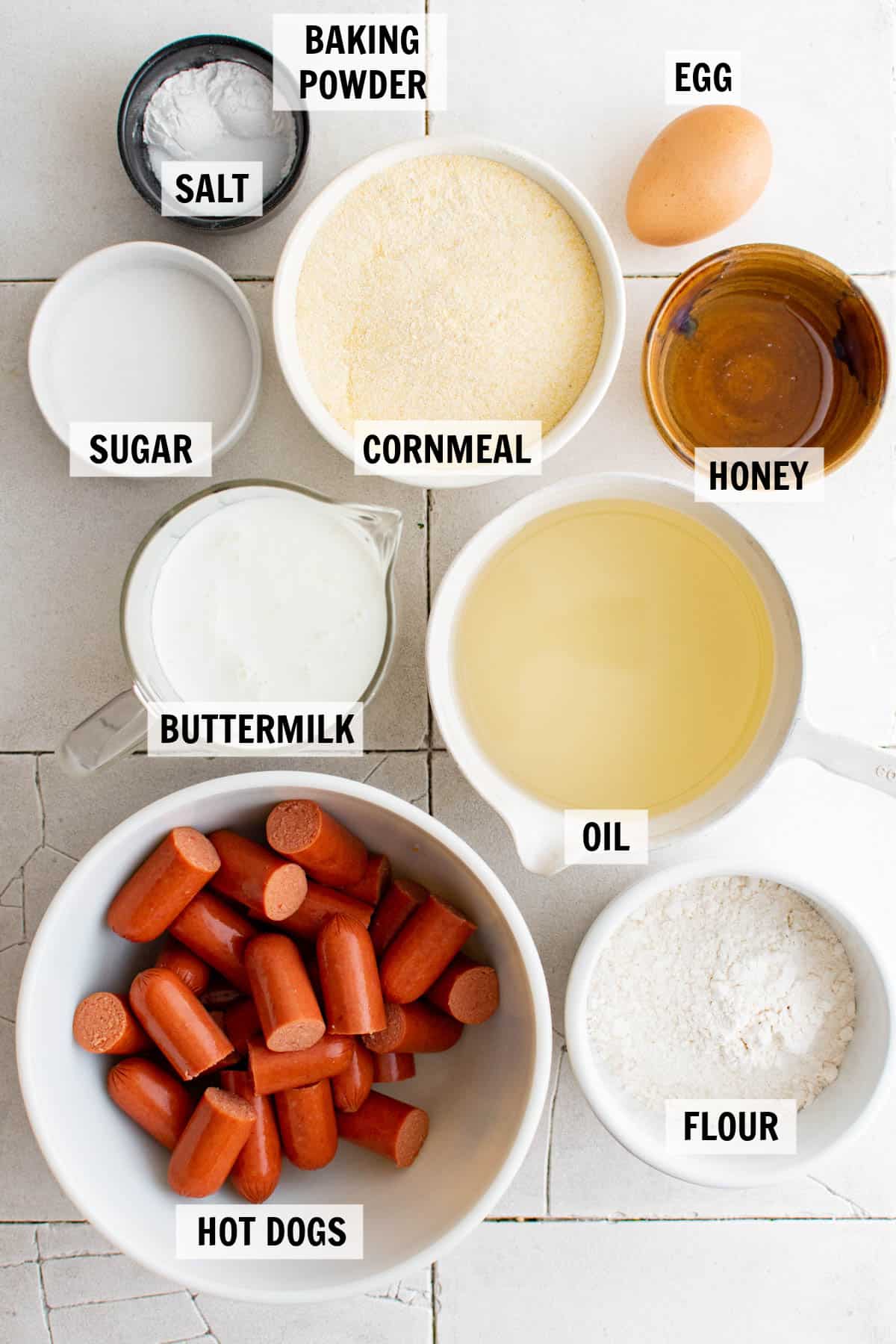Corn Dog Nutrition Information: Facts You Need to Know Usually weighing 220–250 calories, a corn dog boasts 9–13 g of fat and 7–9 g of protein. They also consist of 500–600 mg of salt and 25–30 g of carbs.
Because of their excellent flavor and ease of cooking, corn dogs are a traditional fair and street snack. Corn dogs, created by coating a hot dog in a thick cornmeal batter and deep-frying it until cooked through, offer a unique blend of flavors and textures.
Though they might be a delightful pleasure, their nutritional value should be considered. Their somewhat high calorie, fat, and salt concentration calls for moderation in consumption. Researching homemade or better replacements can enable you to enjoy this meal and yet reach your dietary requirements.

An Interpretive Review of Corn Dog Nutrition Information: Facts You Need to Know
Welcome to our blog post titled “Data about corn dog nutrition: Facts you need to know.” Here we will provide a fascinating overview of corn dogs. Learn the amazing background of these delicacies and their reasons for popularity.
Define a corn dog in your own words.
A corn dog is a hot dog buried in a thick coating of batter derived from cornmeal. Usually deep-fried to golden brown, this mouthwatering delicacy is Fairs, carnivals, and theme parks abound in corndog consumption. Their crispy outside and delicious, savory interior are highly renowned.
History of Corn Dogs
Corn Dog Nutrition Information: Facts you need to know The history of corn dogs dates back to the early 1900s. There is disagreement among food historians on the origin of this snack. Some people believe that German immigrants brought it to Texas. Some claim they created it during a Minnesota state fair. Regardless of its origin, the corn dog quickly gained popularity in the United States.
- 1920: The first corn dogs appeared in the United States
- 1942: The first corndog stand opened at a Texas state fair
- 1950: Corn dogs became a popular fair food nationwide
Nowadays, corn dogs are a common delicacy in American cooking. All ages of people love them, and they are a mainstay at many gatherings.
The division of nutrients
Many people enjoy a dish known as corn dogs. Knowing the nutritional value of foods helps one to make wise choices. Let’s consider the specifics.
The Macronutrients and calories
Macronutrients and calories abound in corn dogs. The following is a breakdown:
- Calories: 220 kcal
- Protein 6 g
- Carbohydrates 24 g
- Fat 12 gm
Vitamins And Minerals
Moreover, included in corn dogs are several vitamins and minerals.
- Vitamin A: 2% of the Daily Value (DV)
- Calcium: 4% of the DV
- Iron: 6% of the DV
- Vitamin C: 0% of the DV
These nutrients support numerous bodily functions. Always check the labeling for exact amounts.
Advantages for Health
A well-liked and delectable snack or dinner is corn dogs. They provide a number of unexpected health benefits. Let’s look at the nutritional advantages of corn dogs.
Content of Protein
Corn dogs provide a significant amount of protein Corn Dog Nutrition Information: Key Facts You Should Know Proteins help to build and repair muscles. Usually a corn dog has around six grams of protein. Both adults and kids might benefit from this. Protein also prolongs feelings of fullness. A corn dog might therefore be a useful snack to stifle hunger.
The Boost’s Energy
Corn dogs might provide a quick energy boost. They contain the body’s main energy source, carbohydrates. One corn dog has around 20 grams of carbs. These carbs provide you energy and keep you alert. We also use fats to make corn dogs. Still another energy source is fat. They keep you going long days.
- Protein 6 gm
- Carbohydrates 20 gm
- Fat 9 gm
Corn dogs are ultimately more than simply delicious. They provide proteins, carbohydrates, and lipids, among other necessary components. These nutrients help you to stay satiated and energetic.
Major Health Risk Factors
Corn dogs are a popular but potentially dangerous delicacy. Understanding these hazards will let you choose food more wisely.
Higher Fat Content
Many times, corn dogs have a lot of fat—especially saturated fat. Foods heavy in saturated fats might raise your cholesterol. This increases one’s chance of stroke and heart disease.
Here is a breakdown of a corn dog’s typical fat composition:
- Total Fat 14 gm
- Saturated Fat 5 gm
- Trans Fat 0.5 gm
Consuming too much fat could cause obesity and weight gain. This raises a diabetic risk as well.
Sodium Of Levels
Corn dogs might have a lot of salt. Too much sodium may raise blood pressure. This raises the stroke and heart disease risk.
Typically, a corn dog contains the following amount of salt:
- Sodium 700 milligrams
According to health authorities, daily salt intake shouldn’t exceed 2,300 mg. One corn dog roughly accounts for one-third of this maximum.
Another possible effect of too much salt is water retention. Bloating and pain might follow from this.
Although you should balance your diet with better alternatives, you can occasionally indulge in corn dogs to lower these risks.
Comparing Corn Dogs to Other Snacks
Corn dogs are a popular dish. They combine a hot dog with cornmeal batter. But how do they stack up against other well-liked snacks? Let’s compare and contrast hot dogs and chicken nuggets with corn dogs.
Hot dogs vs corn dogs
In contrast to hot dogs, corn dogs also contain hot dog sausage. But the coating and treatment alter their nutritional characteristics.
Calorie counts for a typical corn dog are around 200. About 150 calories make up a basic hot dog.
Fat: Corn dogs have approximately 10 grams of fat. Hot dogs contain roughly 13 grams of fat.
Protein: Corn dogs provide around 6 grams of protein. Hot dogs offer about 7 grams of protein.
The outside layer of corn dogs is crispy. Typically, hot dogs are softer. Here’s a brief analogy:
- Calories: Corn Dog 200 g and Hot Dog 150 g
- Fat: Corn Dog 10 g and Hot Dog 13 g
- Protein : Corn Dog 6 g and Hot Dog 7 g
Chicken Nuggets vs. Corn Dogs
Chicken nuggets are another popular dish. We make these from pieces of breaded and fried chicken. Regarding nutrients, let’s treat them as corn dogs.
Calories: About 280 calories make up one serving of chicken nuggets. A corn dog boasts 200 calories.
Fat: Chicken nuggets have roughly eighteen grams of fat. Ten grams of fat make up corn dogs.
Protein: Chicken nuggets offer about 14 grams of protein. Corn dogs provide 6 grams of protein.
Nuggets of chicken have more fat and calories. They have more protein as well. Here’s a brief analogy:
- Calories: Corn Dog 200 g and Chicken Nuggets 280 g
- Fat: Corn Dog 10 g and Chicken Nuggets 18 g
- Protein : Corn Dog 6 g and Chicken Nuggets 14 g
Ingredients In Corn Dog Nutrition Information: Facts You Need to Know
Knowing what ingredients corn dogs include is necessary to make better choices. What ingredients go into making the popular corndog snack? Let’s take a closer look at the typical ingredients and potential sensitivities.
Typical Elements
Corn dogs typically require a few key ingredients. The table below provides a thorough list:
- Hot Dog: Typically, one can make a sausage from beef, pork, or chicken
- Cornmeal: We used ground corn to create the batter
- Flour: Cornmeal and wheat flour combine to make the batter
- Sugar: Sweetens the batter
- Baking Powder: The leavening agent aids in the batter’s rise
- Salt: enhances the flavor of the batter
- Milk: The liquid ingredient smooths out the batter
- Egg: Links the components together
- Vegetable Oil: We fried the corn dogs in vegetable oil
Possible Allergens
Before consuming corn dogs, it is important to take into account any possible sensitivities. The following list of common allergies includes corn dogs:
- Wheat: Flour in the batter contains gluten
- Eggs: Used to bind the batter
- Milk: Makes the batter smooth
- Meat: Hot dogs may contain beef, pork, or chicken
If you have food sensitivity, always check the ingredient list. Certain brands may add various ingredients.
Selecting Healthier Choices
Corn dogs are a popular delicacy. But they often include dangerous materials. With careful selection, you may enjoy a healthier version. The recipes in this area will help you cook healthier corn dogs.
Ways to Make Corn Dogs Healthier
Making a few changes might make corn dogs healthier. Try baking them instead of frying them. As a result, you use less oil. Use whole wheat flour for the batter. It offers fiber and minerals.
Consider using leaner meats, such as chicken or turkey sausages. They contain less fat. You may also use vegetarian substitutes like tofu dogs. Try this simple recipe for a nutritious corn dog:
- Preheat your oven to 375°F (190°C).
- Mix whole wheat flour, cornmeal, and baking powder.
- Add low-fat milk and egg whites to the mixture.
- Dip lean chicken sausages into the batter.
- Bake for 15-20 minutes until golden brown.
Choosing Better Ingredients
Ingredients have a major role in nutrition. Choose organic cornmeal and whole wheat flour. They are healthier than processed options. Choose low-fat milk to save calories.
Look at the labels on the sausages. Choose ones with less salt and no extra sugar. If you’re vegetarian, go for veggie dogs or high-protein tofu.
- Flour: Whole Wheat Flour
- Cornmeal: Organic Cornmeal
- Milk: Low-Fat Milk
- Sausages: Chicken, Turkey, or Veggie Dogs
Making use of these components has a significant impact. Your corn dogs will stay healthy and continue to taste great.
Corn Dogs In Popular Culture
In American culture, corn dogs are a typical snack. They are a popular delicacy because of their crispy outside and delicious inside. Because corn dogs appear in a variety of contexts and mediums, they have established a unique niche for themselves in popular culture.
Corn Dogs at Festivals and Fairs
Fairs and festivals are at the heart of corndog tradition. This popular meal is a mainstay at these gatherings. To indulge in these delicious pleasures, they visit food vendors.
- State fairs
- County fairs
- Music festivals
- Street fairs
At these gatherings, a variety of condiments often accompany the corn dogs. The most common options are ketchup and mustard. Gourmet variations with distinctive tastes are available at some booths.
Corn Dog Media Covers
The media has also noticed the corn dogs. They often show up in cartoons, TV series, and films. Their appearance emphasizes their status as a classic American dish.
The following are a few notable mentions:
- Movies: Scenes from carnivals frequently feature corn dogs.
- TV shows: Characters eat corn dogs during fairs or festivals.
- Cartoons: Animated characters consume corn dogs while engaging in amusing adventures.
These media appearances further solidify the popularity of corn dogs. People view them as a nostalgic and enjoyable treat.

FAQ of Corn Dog Nutrition Information: Facts You Need to Know
What Is the Calorie Content of a Corn Dog?
A typical corn dog has 200–250 calories. The quantity of calories may vary depending on the size and contents.
How Much Protein Is in a Corn Dog?
The protein content of a typical corn dog is between 6 and 8 grams. Depending on the recipe, the amount could vary.
Is There a Lot of Fat in a Corn Dog?
In fact, the average corn dog has 10 to 15 grams of fat. Depending on the cooking method, the amount of fat can change.
Are corn dogs gluten-free?
Gluten is present in most traditional corn dogs.Check the label for gluten-free options.
In conclusion
Comprehending the nutritional value of corn dogs enables you to make informed decisions. Eat them sparingly to maintain a balanced diet. Consider healthier selections and pay attention to portion sizes. This way, you may savor their delicious taste without compromising your health. Keep yourself informed and enjoy your favorite treats in moderation.











